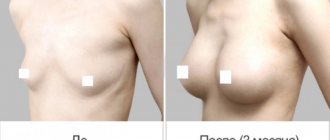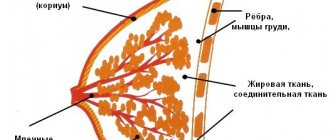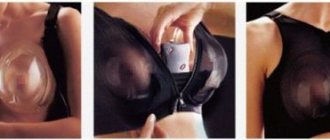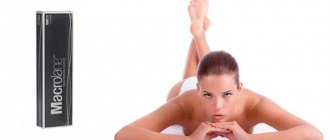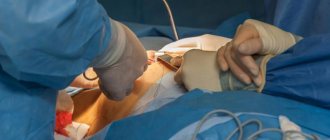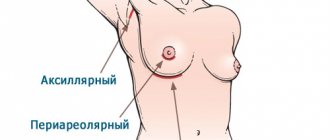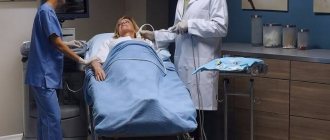HOW TO CHOOSE IMPLANTS: PREOPERATIVE MEASUREMENTS
FULL NAME._____________
Age___Weight___Height___Bodice size before surgery___
Expected Result:
Four types of future breast profiles are shown schematically. The features of these 4 types should be explained to the patient in detail; the choice of one or another type of implant will depend on this and it will be clear how to choose the right implants.
Parameters of breast prostheses
The size of each implant, including anatomical ones, is calculated in milliliters. This means that for 1 chest size there is a filling volume of 150 ml.
The size of the endoprosthesis is added to the natural girth of the bust. Thus, a woman with size 2 acquires breasts with indicators of size 4.
In addition, there are adjustable and fixed implant sizes. The former are characterized by the introduction of filler into the membrane during surgery after implantation of grafts.
This allows the surgeon to make adjustments to breast size during the surgical period, increasing or decreasing the volume of the planned bust.
The peculiarity of the latter is that after implantation into the mammary gland, their size cannot be changed.
HOW TO CHOOSE IMPLANTS BASED ON THE PATIENT’S WISHES
- TYPE 1. The patient expresses a desire for a slight breast enlargement, which has a natural (teardrop-shaped) shape with a slight fullness of the upper slope. The patient understands that with her initial parameters it is possible to install a larger implant, but nevertheless insists on a conservative increase. The surgeon should think about low-profile implants.
- TYPE 2. The patient wants to install implants with the largest possible volume, but at the same time does not want to end up with breasts that have an unnatural appearance, that is, excessive fullness of the upper slope. The patient does not want it to be noticeable that breast augmentation surgery has been performed. The surgeon can choose round implants with a medium profile or anatomical implants with a medium (high profile).
- TYPE 3. The patient wants a large breast enlargement and does not mind if the breasts have a slightly unnatural (unnatural) appearance, that is, a well-filled, rounded upper pole of the mammary glands will be noticeable to others. The surgeon chooses round implants above the average profile (medium “plus”) or anatomical implants with an ultra-high profile.
- TYPE 4. The patient wants breast augmentation with implants of the largest possible volume and understands that this will create a completely unnatural appearance and it will be obvious to others that an operation has been performed. In this situation, the surgeon uses round implants with a high or ultra-high profile.
Dressings and home care
Already on the operating table, the patient is put on special compression garments, which must be worn for 1 month.
After the procedure, the surgeon individually prescribes dressings. Typically 2-3 appointments may be scheduled within a week.
At home, you should treat yourself as carefully as possible and adhere to the following rehabilitation rules for a month:
- sleep on your back
- don't lift weights
- don't play sports
- do not smoke or drink alcohol
- wear compression garments day and night
- protect skin from sun for 3-4 months
- avoid stress, get proper rest
HOW TO CHOOSE IMPLANTS ACCORDING TO THE PATIENT’S INITIAL DATA
To understand how to choose implants correctly, the surgeon must evaluate tissue turgor, the so-called “skin pocket”. This is important in terms of assessing the real possibility of filling this “pocket” with an implant. So:
- ELASTIC - indicates that the breast may have a small space for the introduction of implants, which will strongly compress and put pressure on the chest, reducing the projection of the prosthesis. In this case, it is best to install low or medium profile implants.
- MODERATE (MEDIUM) - evidence that the skin pocket is slightly relaxed, but at the same time not excessive. Here it is possible to install implants with an average or above average profile.
- FLABLE (LOOSEN) - indicates a noticeable loss of elasticity and the presence of excess skin. In this situation, surgery with the installation of high-profile implants is indicated.
Disadvantages of silicone implants, negative consequences of their installation
The disadvantages of such products are the following:
- the occurrence of capsular contracture;
- the likelihood of cracks, ruptures, and leakage of filler;
- the risk that the endoprosthesis will burst under high load (for example, when dropped on the chest);
- silicone provokes autoimmune diseases - systemic lupus erythematosus, vasculitis, rheumatoid arthritis, systemic sclerosis;
- decreased sensitivity of the bust, especially the nipples.
Possible complications:
- postoperative hematoma requiring surgical removal;
- impaired sensitivity when installing large endoprostheses;
- in the postoperative period – breast swelling due to the accumulation of fluid in the cavity of the product;
- bias;
- inflammation that requires urgent removal of the endoprosthesis (another one can be installed only after complete healing);
- gel migration over time;
- prolapse of implants, especially if they are large (in this case, after a certain period of time, you need to re-install other silicone implants).
HOW TO CHOOSE IMPLANTS: WE MAKE MEASUREMENTS
- The distance from the jugular notch to the nipple (Sternal Notch to Nipple - SN-N) is carried out with a measuring tape. It can vary from 16-18cm in short patients, to 19-21cm in tall patients with small breasts. This parameter is important for assessing the symmetry of the location of the nipples.
- The distance from the middle of the collarbone to the nipple (Clavicle to Nipple - CN) is also determined with a measuring tape. This line is called the median meridian.
- The width of the base of the breast - (Breast Base Width - BBW) is determined using calipers with a slide rule. It is one of the main parameters in the question “How to choose implants?”. In some cases (wide interbreast distance - more than 3-3.5 cm), for example, in patients with tubular breasts or a narrow base of the mammary glands, the width of the base of the breast can be increased due to implants. Accordingly, the interthoracic distance decreases to the average size.
- Breast Height - BH - distance from the inframammary fold to the upper border of the mammary glands. This parameter is important in choosing the height of anatomical implants.
- Medial Pinch - is determined by gripping (pinching) the skin with subcutaneous fat between the index and thumb along a conventional axis between 11 and 5 o'clock on an imaginary dial. Determined by special calipers.
- Lateral Pinch - the measurement technique is the same as for the medial pinch, along a conventional axis between 1 and 7 o'clock. The dimensions of the medial and lateral tucks are important for choosing the width of the implant base.
- Upper Pole Pinch - measured by capturing the skin with subcutaneous fat in the upper pole of the mammary gland in the projection of the conventional axis between 3 and 9 o'clock. The thickness of the upper tuck is important for choosing the method of installing implants - under the gland (subglandular) or partially under the muscle (submuscular). Considering that there is a double layer of tissue between the two fingers gripping the skin with subcutaneous fat, the true value of tissue thickness will be equal to ½ pinch test. For example, if the pinch test is 2 cm, then the true tissue coverage over the implant will be half, that is, 1 cm. It is believed that if the pinch test in the upper pole is less than or equal to 2 cm, then the round implant can be contoured and, therefore, its upper pole should be placed under the muscle. According to D. Hammond, for subglandular placement of anatomical implants, a coating thickness of ½ cm is sufficient (pinch test is 1 cm).
- The distance from the nipple to the inframammary (submammary) fold - (Nipple to IFM - N-IFM) - is measured with a centimeter tape from the nipple to the IMS (SMS). For small breasts with good skin turgor, this distance is 5-6 cm on average.
- The distance from the nipple to the inframammary fold when the skin is stretched - (Nipple to IFM (stretched)) - is determined at the maximum stretch of the breast skin in the lower pole. This test can be used to judge the firmness and elasticity of the skin. If this distance is more than 7-8 cm, then along with endoprosthetics, the possibility of performing a periareolar or vertical breast lift cannot be ruled out.
- Areola diameter - measured along the vertical and horizontal axis. Allows you to determine the size of the areolas, their asymmetry, the need to reduce the diameter, and the possibility of performing periareolar access. For example, with small areolas (about 3 cm), installing implants, especially anatomically shaped ones with a more cohesive gel, using periareolar access will present certain difficulties for the surgeon and lead to unnecessary trauma to the patient’s tissues surrounding the incision.
- Interthoracic distance (true cleavage) is the distance between the medial (internal) borders of the mammary glands. Measured with a measuring tape.
In patients with small breasts, the average is 3-3.5 cm. This parameter can exceed 3 or more centimeters in patients with tubular breasts or a narrow base of the mammary gland. In such cases, the width of the base of the future implant should, accordingly, increase by ½ the difference between the true and desired cleavage (but not less than 3 cm). For example, a patient’s true cleavage is 5 cm. In this case, to the selected width (see below) of the future implant, you need to add ½ the difference between the true (5cm) and the desired cleavage (3cm), that is, half of 2 (1cm).
What is anchor mastopexy
There are several surgical methods for bust rejuvenation:
- with a suture along the areola - periareolar lift;
- with a vertical seam (from the edge of the areola down to the inframammary fold) – vertical lift;
- with a seam in the shape of an anchor, or an inverted letter T - anchor (T-shaped) suspender
See more “Before” and “After” photos
What do we understand by “rejuvenation” of the mammary glands? An aesthetic medicine specialist faces four global challenges :
- Raise the mammary gland and nipple-areolar complex to a level typical of young and elastic tissue.
- Remove excess stretched skin.
- Adjust the shape of the areola. After giving birth, few people can boast of beautiful, clearly defined areolas.
- Add volume if there is a deficiency of adipose and glandular tissue.
Anchor mastopexy is intended for breast lift in cases of very severe ptosis (when the nipple is lowered more than 3 cm below the inframammary fold). The surgeon combines incisions:
- circular along the areola to move the areola several centimeters higher,
- vertical from the lower edge of the areola to the submammary (inframammary) fold,
- horizontal in the underore fold.
⇒ WE ALSO ADVISE YOU TO READ: Breast augmentation: personal experience. The story of a mother of two children
HOW TO CHOOSE IMPLANTS: WHAT TO PAY ATTENTION TO
When filling out this “Observations” section of the worksheet, the surgeon notes all the structural features of the mammary glands, chest, existing asymmetry, etc.
Breast shape: - tubular, round, conical, wide, narrow, etc.
Breast examinations - the presence of any formations, lumps, scars, etc. is determined.
Chest volume (presumably) Right_____________ Left_____________
Difference_____________
Asymmetry: Chest_____________Chest_____________
Nipple level_____________
Submammary fold_____________
How to stop being afraid of scars
Let's be honest: you are afraid of large scars on your body. On the chest, even more so, because this is the epicenter of female sexuality. Many women perceive stitches as a sacrifice to a beautiful shape and have difficulty reconciling themselves with the need to have them.
I want to give you a different perspective.
- First: let's start with the aesthetic perception of the bust. The shape of the bust is more important than the condition of the skin surface. Let this be a discovery for you, but men pay attention to the shape of the breast and the shape of the areola.
- Second: the visibility of seams can be reduced. If sutures are applied correctly and properly cared for during the rehabilitation period, within a year, instead of the inverted letter T, you will see barely noticeable whitish stripes.
HOW TO CHOOSE IMPLANTS: PLANNING THE OPERATION
Type of operation: - what is planned by the surgeon - augmentation (increase), revision or reconstruction.
Planned date of surgery: ____________
Planned change in the level of the inframammary fold: raising, lowering, or remaining unchanged.
Preferred size: Volume ____________
Profile:_____________Base Width (measured with slide rule calipers) - BBW_____________
Access: Submammary, periareolar, axillary, other (check as appropriate).
Implant location: subpectoral, subglandular (under the gland), subfascial (mark as necessary).
Implant base: (basic width)___________ (determined by the formula: width of the base of the breast - (minus) ½ thickness of the fold of the medial pole - (minus) ½ thickness of the fold of the lateral pole.
What physical problems does surgery solve?
- Very small breast size due to heredity or hormonal deficiency
- Moderate asymmetry (in case of strong pronounced asymmetry, a combined technique can be used - breast lift + augmentation)
- Loss of volume and shape after breastfeeding
- Deformation after weight fluctuations
In my opinion, the most important task that augmentation mammoplasty solves is the restoration of self-confidence and love for your body
TYPES OF IMPLANTS
Implant type:
- round;
- teardrop-shaped (anatomical).
HOW TO CHOOSE ROUND IMPLANTS
- The gel chosen is Mentor’s Cohesive I (the softest gel) or Cohesive II (a denser gel). Similar to Cogesive II - Mak Gan has round implants with Soft Touch gel). Round implants with a denser gel are preferable to install in patients with poorly developed subcutaneous fat and breast tissue, that is, when there is a risk of “waves” (ripples) appearing due to the softness of the gel.
- Select a profile: Mentor has medium, medium plus, high, super high.
HOW TO CHOOSE ANATOMICAL IMPLANTS
Selected according to 3 main parameters:
- width;
- height;
- profile (projections).
Mentor has 5 types of teardrop implants. Mak Gan (formerly Inamed corporation, then Allergan) has similar implants of the Matrix system. See the comparative table of teardrop-shaped implants from these 2 companies.
When choosing round implants, the main parameter can be taken as the basic width of the implants, as well as the volume and projection. To understand how to choose implants, D. Hammond offers the following algorithm.
So, for example, having chosen the basic width of the implant after appropriate measurements, the next step is to select the volume and projection (or vice versa).
It is clear that an interval in choosing the width of the implant within 5-6 mm is quite acceptable, since each surgeon can measure the base of the mammary gland or the thickness of the covering tissue (pinch test) differently.
Many surgeons, when choosing implants, focus on volume as the main parameter, then the next steps will be to select the appropriate base width and projection (or vice versa).
When choosing drop-shaped implants, in addition to width, volume and projection, the height of the future prosthesis is also taken into account, which is selected according to the height of the patient’s chest. For this purpose, there are anatomical implants of full, medium and low height (see the comparative table of implants using the example of Mentor and Mac Gun).
How much does an anchor breast lift cost?
Prices depend on the complexity and degree of ptosis. You need to make an appointment with surgeon Vladimir Kosinets so that he can conduct an examination and tell you the exact cost of the intervention.
| Breast plastic surgery (mammoplasty) | Price |
| Breast augmentation with anatomical implants | 230 000 |
| Breast augmentation with round implants | 200 000 |
| Repeated mammoplasty | 260 000 |
| Periareolar mastopexy with breast augmentation | 250 000 |
| Vertical mastopexy with breast augmentation | 280 000 |
| T-shaped mastopexy with breast augmentation | 300 000 |
| Vertical reduction mammoplasty | 200 000 |
| T-shaped reduction mammoplasty | 250 000 |
Sign up for a free consultation with plastic surgeon V.A. Kosinets. done by phone or through the feedback form on the website.
HOW TO CHOOSE IMPLANTS USING OTHER METHODS
Despite the apparent complexity of the Body Logic system, in fact, for an experienced surgeon, the process of measuring a patient’s parameters and selecting the appropriate implant takes no more than 15-20 minutes. The presence of sizers (implants for fitting) will greatly facilitate this task and help the patient assess the size and shape of the future breast.
Of course, there are many other ways to select implants, proposed by various authors (for example, the scheme of Dr. Tebbetts and Per Heden and even the computer program developed for this by Dr. Stan). On the contrary, many surgeons rely only on their experience, eye and intuition, and probably have very good results. There cannot be certain dogmas in plastic surgery. The one who has excellent and long-term stable results is right. How he achieves this is the second question.
Division of endoprostheses according to the composition of the filling fluid
The outer wafer of any transplant is made of soft silicone and filled with a special gel or isotonic saline liquid, similar in composition to a sterile solution for injections.
Such a mixture, even if it leaks, is harmless to a woman. It will only be absorbed into the blood, just as a liquid comes from an IV into the body to flush the body.
It is also captivating that these implants cost less than other types of endoprostheses. In addition, they are softer to the touch.
But there is also a drawback to using such grafts. With them, the chest is heavier and looks unnatural, and often makes gurgling sounds when moving.
Implants containing a biocompatible cohesin (non-flowing) gel are incomparably lighter. With these endoprostheses, the bust acquires improved elasticity and a natural appearance.
The specific composition of gelatin ensures, when pressing on the bust and when its owner moves, a return to the natural shape of the breast without issuing third-party “chords”.
The disadvantage of this gel is that if it leaks, surgical intervention will be required.
In addition, plastic surgeons have breast implants with a smooth silicone or textured outer surface.
And these endoprostheses for mammoplasty have their advantages and disadvantages. Thus, smooth ones are prone to shifting, and grafts with a textured shell, albeit sometimes, when in contact with the subcutaneous tissue, cause wrinkles.
In 87% of cases, as practice shows, doctors today use silicone implants.
Practicing plastic surgeons, as a rule, do not favor smooth or water-filled implants. The former are prone to slipping and turning over. The latter decrease in volume over time as the liquid evaporates. Due to these reasons, the risk of reoperation increases significantly, and long-term results are not satisfactory.
Features of wearing compression garments
Breast augmentation is an operation that requires the mandatory wearing of special compression garments for one month. Even on the surgical table, the patient is dressed in a special bra.
Why wear compression garments?
- After the procedure, the breasts are painful and swollen. The linen has massage properties, normalizes blood circulation and accelerates healing.
- Oscillating movements of the mammary glands cause additional discomfort. The underwear tightly fixes the tissue and thereby reduces pain.
- Maintains the correct position of tissues and prevents rotation of breast prostheses.
- Prevents the formation of stretch marks.
- Relieves tension and back pain.
It happened that patients ignored the rules, this immediately affected their well-being.
A month after small breast augmentation, the compression bra is replaced with a thick, wire-free top.
READ ALSO: Rules for rehabilitation after breast augmentation
The secret of the seamless technique
The location and size of sutures are traditionally objects of particular concern for patients. Today the phrase “seamless operation” is popular. But is it possible to have a breast enlargement without a stitch from a surgeon?
During breast surgery with implants, the specialist always makes incisions. When we announce a sutureless technique, it means that the seam is almost invisible, but this does not mean that the surgeon does not work with a scalpel.
How is an invisible seam made?
I make an incision along the lower edge of the areola. I carry out implantation through the resulting small hole. This requires the dexterity and skill of the surgeon, the size of the implant is significantly larger than the diameter of the hole.
After placing the implant, the surgeon sutures the breast tissue. After fixing the tissues with an internal suture, the skin flaps are compared and secured with a special surgical glue instead of threads. The glue powerfully holds the wound edges in contact and hermetically blocks the penetration of bacteria that cause local inflammatory processes. That is, skin glue performs fixing and protective functions.
Some time after the operation, the patient independently removes the remaining glue from the scar. The usual suture removal procedure is not required after using this technology.
On the day of surgery
- We invite the patient to the clinic at the appointed time. You need to take a package of ready-made tests, a passport and money with you.
- Surgery using breast endoprostheses is performed under general anesthesia, so the last meal is allowed the night before.
- In the clinic, an anesthesiologist and resuscitator talk with the patient. The plastic surgeon draws special markings on the body. The operating team is preparing the patient for plastic surgery.
- At the end of the surgical intervention, the patient is transferred to the recovery room, where, under the supervision of specialists, she comes to her senses.
- The woman spends a day in the clinic, the next day she goes home for rehabilitation. The plastic surgeon sets dates for dressings.
READ ALSO: Breast augmentation marked the beginning of my new life!
